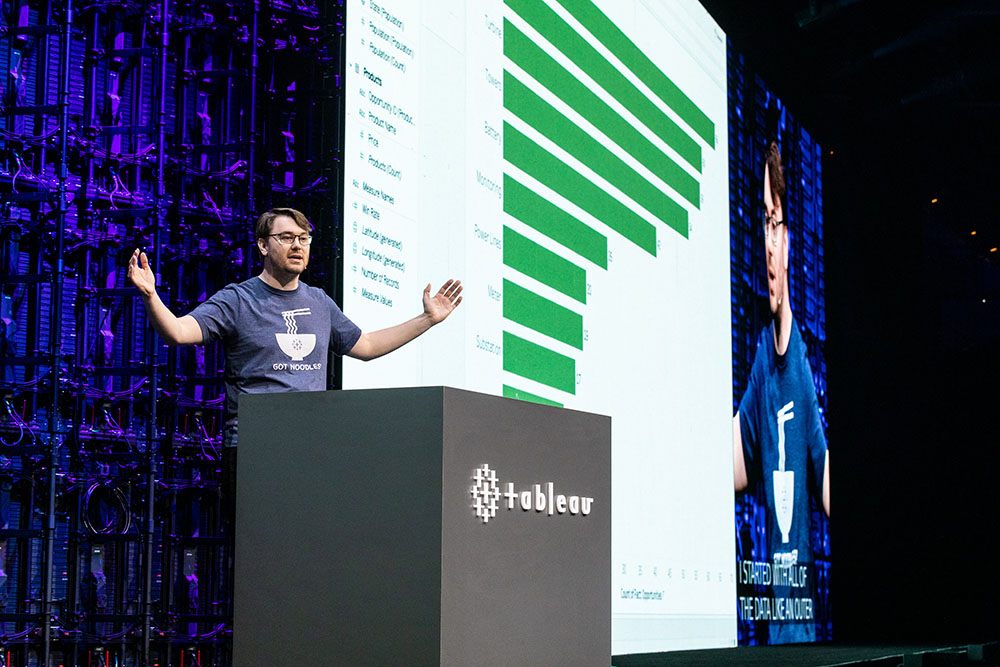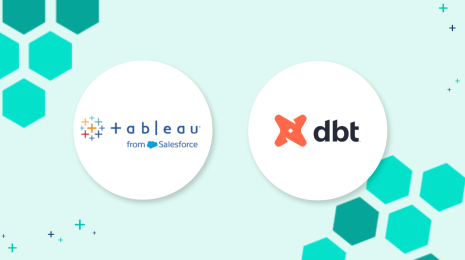Devs on Stage dazzles: Dynamic Parameters, Noodles, and Animation are simply the best

Meet Tyler, Manpreet, Victoria, Filippos, and Sara: this year’s Devs on Stage
Every year, thousands of data rockstars come together at Tableau Conference to be among the first to get a close look at the newest Tableau capabilities. We call this convergence Devs on Stage, and it’s been a fan favorite from the beginning. Devs on Stage is where you hear about Tableau innovation directly from the people building it—the developers themselves.
This year’s wickedly talented devs are Victoria Wagner, Manpreet Kaur, Tyler Beauchamp, Sara Rantschler, and Filippos Lymperopoulos. They dragged and dropped their way into the audience’s hearts with their entertaining and informative demos. And judging from the reaction, our customers can’t wait to take these new features for a spin! Read our recap and you’ll find out why.

Tableau’s Chief Technology Officer Andrew Beers welcomes everyone to Devs on Stage
Ready, set, animate!

Victoria explains why animations are "simply the best"
Software Engineer Victoria Wagner is not only obsessed with data, she’s obsessed with tea! Victoria used a viz about international tea exports to illustrate just how easy and impactful it can be to animate your data, and discover multiple insights with just a click. The new Animations feature unlocks new levels of understanding from a single interaction, and brings static dashboards to life with animated flair—no setup required.

When animations aren’t needed, they can be turned off at the worksheet, workbook, or user level. To compliment animations, we’re also bringing the Play button to the web. Together, these capabilities greatly enhance your data storytelling toolkit. Look for mark animations coming to Tableau Desktop, Tableau Server, Tableau Online, and Tableau Public next year.
Here are more highlights from Victoria’s demo:
PDF Bursting (Released with 2019.3): Victoria showed us how to improve collaboration with the power of personalized PDF subscriptions. By using PDF subscriptions with user filters, PDF bursting is just a few clicks away. Check out this blog post to learn more.
Web Authoring and Explore to Investigate on Tableau Public (Coming next year): Victoria got everyone’s attention when she showed us the magic of Web Authoring on Tableau Public, using an existing viz about James Patterson books. Using the new Explore capability, you can edit the viz, and quickly create insights of your own, right in the browser. When you save the edited viz as your own, Tableau Public will automatically provide attribution to the original author.
Prep is ready for its close-up with List View, Fixed LOD, and more

Manpreet demos Prep's new superpowers
Senior Software Engineer Manpreet Kaur is serious about data. So serious, in fact, that she moved 8,000 miles from sunny Australia to rainy Seattle to join Tableau. And for Manpreet, Seattle life also means she’s been watching a lot of movies—and creating a lot of datasets to answer her most serious cinematic questions!
Here’s what Manpreet shared in her demo:
Rank (Coming next year): Manpreet showed how easy it is to enrich data, directly in Tableau Prep. But using the new Rank function, Manpreet created ranked list of top-grossing movies, revealed in just two clicks. We think that Rank rocks—and you will, too.
Fixed LOD (Coming next year): Ordinarily, aggregating data at a consistent level of detail, to make it easy to analyze is a multi-step process. Using Fixed LOD, Manpreet showed how she used her data to create a dataset of ticket sales by genre in a single step. Faster data prep leaves more time to watch movies, right Manpreet?
Reusable Steps (Coming next year): In many use cases, you’ll want to reuse certain cleaning steps across multiple flows. Today, that means recreating each step manually. Manpreet explained how reusable steps makes that a thing of the past. She can even share these steps with her team, using Prep Conductor.
Incremental Refresh (Coming next year): Once you have built a flow, in most cases you only need the latest data. Manpreet explained that she uses a flow to clean tweets she receives from customers—but instead of processing every single tweet every single time she runs this flow, what she really wants to do is process the new data only. With Incremental Refresh, she can do just that, saving time and reducing backgrounder workloads.
List View (Released with 2019.3.2): Using this new Tableau Prep feature, Manpreet showed how simple it is to transform hard-to-navigate fields into a clean list—without losing any of the functionality you have using fields. Selecting List View, she quickly produced a view of the 500 top-grossing films from a master dataset of 7,000. Faster time to insights leaves more time to watch movies, right Manpreet?
Try the Noodles. They pair well with Enhanced Data Models, and a side of multifact schemas!

Tyler noodles around with Noodles
Senior Software Engineer Tyler Beauchamp has a passion for making data modeling easier, automatic, and more flexible. As a dev on the data modeling team, he gets to pursue his passion, every day, and help everyone unlock richer analytics. He demoed new enhancements that will allow users to handle multiple levels of detail in a single data source without having to learn advanced database concepts or write custom SQL code. According to Tyler, “Gathering and shaping data for analysis is now as drag and drop easy as building a visualization!”
Here’s more from Tyler’s demo:
Relationships (Coming next year): Relationships are everything, and with Tableau’s latest data model enhancement, Relationships, it’s love at first sight. Tyler’s demo showed just how amazing it is to be able to answer multiple questions by seeing all your data and letting Tableau dynamically shape the data through direct interactions with your viz.

Tyler wasn’t talking about ramen when he explained what happens when ordinary joins become Noodles. His demo showed us how powerful—and fun—Noodles can be for defining relationships between tables. Using Relationships, you don’t have to decide in advance what type of join to use, or what your level of detail should be. Relationships allow Tableau to use your analysis, intelligently, to choose the correct LoD for each visualization.
Level up your admin game with the latest Tableau Server tools

Sara shares her excitement about Server tools
Quality Assurance Engineer Sara Rantschler manages 20 Tableau servers as part of her role as the server admin for the Tableau Dev team’s server environments, used for product testing. As a server admin and Pokemon Go enthusiast, she knows Lucky Eggs when she sees them—and the latest updates for Server definitely qualify. Admins, get ready to level up!
Here’s what Sara shared in her demo:
Login-based License Management (Coming next year for role based customers): Who needs keys? With this new feature, Creators can activate Tableau Desktop or Tableau Prep by simply logging-in to these products with their Server credentials—no product key needed. Sara demonstrated how easy it can be to assign, monitor, and reclaim Tableau Desktop or Tableau Prep access from Server, instead of distributing license keys to your users. Key takeaway: don’t need 'em.
Resource Monitoring Tool (Tableau 2019.3): Tableau’s Resource Monitoring tool give you the insights you need to assess the health of all your Tableau Server deployments. The Resource Monitoring tool goes deep, allowing admins to see details of vizql sessions, background tasks, and queries being sent to the database. With the tool, Sara could quickly zero in on a viz load time spike, and pinpoint high levels of backgrounder activity as the root cause.
Content Migration Tool (Tableau 2019.3): What if you could manage, migrate, and transform workbooks without ever opening Tableau Desktop? Sara gave us reasons to say yes to a smarter way to do all these things using the Content Migration tool. She showed us how you can programmatically build workbook migration workflow without scripting. You can move dozens of workbooks between sites, remap data source connections, and even change a beta stamp within the workbook itself. Stamp that approved!
Dynamic data is the best data

Filippos gets everyone excited about Set Control
Interactive Analytics Product Manager Filippos Lymperopoulos kicked off his demo with a little horsing around. “My name is formed from two Greek words: “filos” means friend, and “ippos” means “horse,” he explained. His demo made it clear that he’s also a friend of all things Tableau. Efharistó polí, Filippos, for showing us how this trifecta of features makes it easier than ever to get from insights to action to the winner’s circle!
Here’s more from Filippos’ demo:
Dynamic Parameters (Coming next year): You asked, Tableau delivered! The most requested feature on the Tableau Ideas Forum is on its way. Say hello to Dynamic Parameters—and say goodbye to republishing workbooks with parameters every time the underlying data changes. With dynamic parameters, an author can set it so Tableau will update the parameter value automatically based on a rule, such as refreshing the date when the workbook opens. Filippos wowed the crowd by showing how easy it is to have a parameter set to the latest date.

Set Control (Coming next year): Filippos used a dataset about music to show us how seamless it is to put the power of sets to work. As he explained, sets are merely collections of values. Using Set Control, it’s possible to ask questions—like, who’s the most popular musical artist in his native Greece? How does that compare with other countries? Set Control is compact, searchable, customizable, and incredibly valuable when used in calculations. Everyone is able to jump in and interact with an author’s calculations using Set Control, and create their own unique insights on the fly.
Spatial Buffers (Coming next year): Filippos gave us a look at the Next Big Thing in Tableau’s geo-spatial toolkits: buffer calculations. With buffer calculations, Filippos explained, you can give Tableau three parameters⎯location, distance, and unit of measure—and a buffer, or boundary, is instantly created! In Filippos’ demo, the result is an interactive map that shows where potential Airbnb sites intersect with existing hotels. Buffers are the secret sauce that helps you understand proximity between marks, and gives you new ways to filter and aggregate your data, spatially.
#DataFam, we heart you
Fun fact: there’s [null] Tableau without our community!
What we do is all about you—our amazing, creative, and fearless Tableau Community. The #datafam motivates us to show up every day, and continue innovating, so you can bring your data insights to life in mind-blowing new ways. The feedback that you share with us is reflected in every update, and every new release. So, dive head-first into these new developments and tell us what you think. As always, we’re listening.
We invite you to join the Tableau pre-release community and give the new features a spin. Missed the other major #data19 announcements? Read the opening keynote recap.








